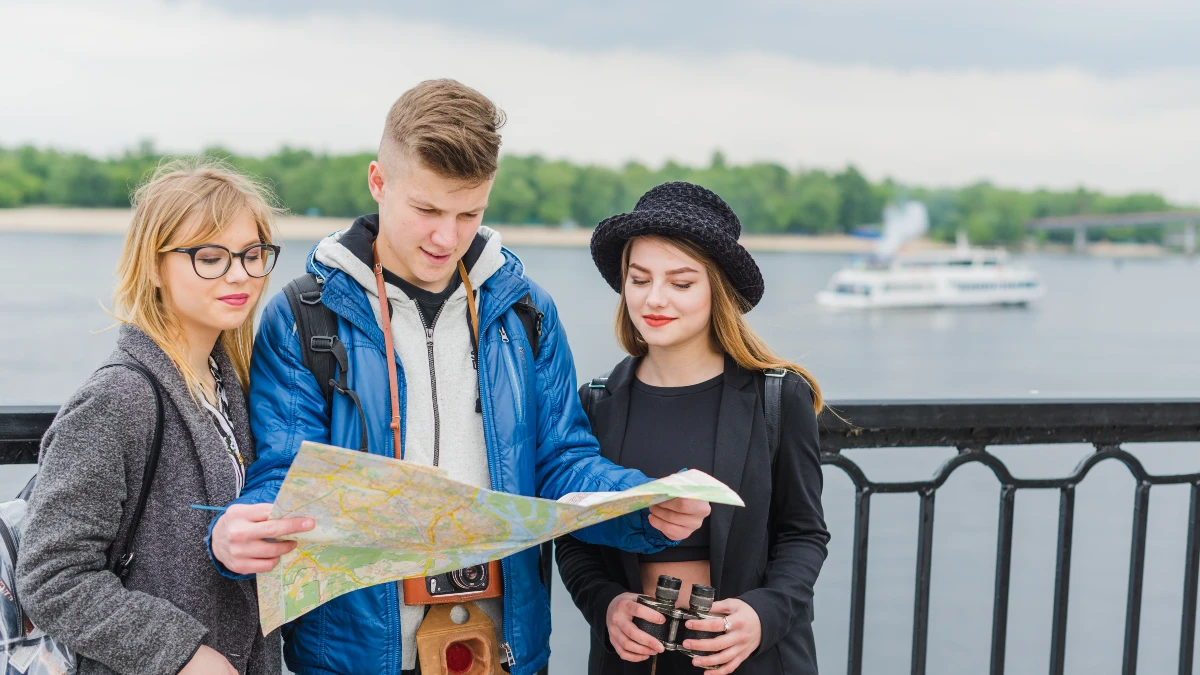Stop wasting your money and vacation time fighting crowds in Paris or Rome. The secret to an amazing, affordable European trip in 2025 is hiding in plain sight. It is not in the famous city squares you see on social media. It is exactly where the locals from those busy, expensive cities go to truly relax.
They are escaping high costs and tourist traps. This guide will take you far beyond the usual spots. We call them the Boring Countries Locals Vacation In, but they are actually high-quality gems. You will learn the exact destinations and smart travel strategies used by European residents.
Get ready to ditch the queues, find real culture, and discover your best budget-friendly escape yet. We call this the Great European Travel Reversal, and it starts now.
Why Locals Skip Famous Cities: Value and Quietness
Why Smart Travelers Are Shifting
The “Push” Factors
- Sky-high prices
- Overwhelming crowds
- Rising living costs for locals
- Inauthentic experiences
The “Pull” Factors
- Excellent value for money
- Authentic local culture
- Unique, undiscovered gems
- Relaxing, low-stress breaks

The big change in European travel happens for two reasons. The first is the “push.” This is the high cost and too many people in the popular spots. The second is the “pull.” This is the real culture and amazing value found somewhere else. When you look at this, you see that the decision to visit a seemingly less exciting place is a smart choice for locals. They want a better experience and better prices.
The Great Exodus: Overtourism and Economic Pressure
Major tourist centers cost too much money for people who live nearby. They are also getting tough for visitors who want genuine value. Countries like Monaco, Iceland, the United Kingdom, Switzerland, and Spain are named as Europe’s most expensive places for vacation rentals. This high price sets a baseline that sophisticated European travelers actively try to avoid.
Overtourism also hurts the people who live there. Almost 60 percent of concerned Americans say that too many tourists cause the rising cost of living for locals. This economic pressure forces people to look outside their expensive area for a relaxing break.
Industry experts are shifting their focus. They used to just want more and more tourists to make more money. Now they see the harmful side effects on culture and the environment. They now focus on finding visitors who bring high value with a lower social impact. This change matches what smart travelers want.
The New Priority: Finding Value and Quietness
Europe’s Changing Travel Horizon (2025)
Overall, 77% of Europeans intend to travel within the continent, with a clear trend towards avoiding crowds and high costs.
The appeal of Affordable European Alternatives 2025 is greatly influenced by the desire for less crowded places. Data shows that 77 percent of Europeans plan to travel within the continent. More than half (55 percent) are actively looking for off-the-beaten-path spots for their next trip. This is a clear shift away from traditional hotspots, which only 45 percent of people now want to visit.
This preference for quietness is directly tied to cost. The German market is one of Europe’s largest for travel. Germans are clearly moving to cheaper holiday options. Places like Bulgaria and Tunisia are seeing big growth in German bookings. This confirms that finding cost-effective places is a major priority in 2025 travel decisions. Escaping high prices and crowds is the main driver for many European travelers.
Reframing the Boring Countries Locals Vacation In
German Travelers’ New Favorite Destinations
Primary Driver: Escaping High Costs & Crowds
The German market, a major force in European travel, is actively shifting towards destinations offering significant cost savings and a quieter experience, confirming a continent-wide trend.
People call these the “boring” countries. That name is wrong. They are simply “pre-discovery” spots. They haven’t been marketed much yet. They offer great experiences. You get natural beauty, real history, and real culture. There are no huge crowds stressing the city.
The destinations once seen as ultimate budget escapes, like Prague and Krakow, have become more expensive. They are only “cheaper” than places like London or Paris, but they are no longer truly “cheap.” This lack of real low-cost spots pushes the most value-seeking travelers to overlooked areas. These include countries known as the continent’s cheapest: Kosovo, Moldova, North Macedonia, Serbia, and Belarus. Lithuania is a Baltic gem. It is valued for its beautiful, old towns, forest lakes, and calm countryside. It appeals to travelers who like slower, quieter trips. This focus on a deeper experience is what local travelers prefer.
The table below shows the difference between the famous places and the emerging alternatives. It summarizes why travel is changing in 2025:
| Factor | The Famous Destination (e.g., Rome, Paris) | The Local’s Escape (e.g., Albania, Slovakia) |
| Primary Tourist Concern | Overtourism (Pollution, high local cost of living, overcrowding) | Value, authenticity, less stress, nature access |
| Accommodation Costs | Most expensive in Europe (e.g., Monaco, Switzerland) | Low initial base cost; high availability of budget/unique stays |
| Growth Model | Focused on high volume and quantity | Focused on high quality and lasting tourism |
| Travel Intent | Checking off bucket list items and main landmarks | Seeking slower, deep, and local journeys |
Cheapest Balkan Holidays: Where Locals Find Big Savings

Southeastern Europe, especially the Balkans, is the perfect choice for Western Europeans who want real experiences and much lower costs. This region offers clear examples of Cheapest Balkan Holidays. The high-cost neighbors, especially Italians, confirm this choice by traveling there easily.
Albania: The Adriatic’s Fastest Growing Secret
Albania is growing fast as a European travel spot. It has great views, kind people, and cheap prices. This makes it a natural place for visitors from high-cost Mediterranean countries like Italy. They can cross the Adriatic Sea for amazing value.
The best proof of high, sustained local flow is in the ferries. The ferry routes between Italy and Albania in 2025 are dense and reliable. Ferries leave from Italian ports like Ancona, Brindisi, and Bari. They arrive in Albanian towns like Durrës and Vlorë. The Bari to Durrës route is very popular and runs all year. You can take your car on all these ferries. This strongly suggests that Italian families use Albania as a regular, low-cost summer base. Tickets for this 8 to 10 hour trip start affordably, around €46.
Even with prices rising slightly due to growing interest, Albania stays very affordable. You can live comfortably on a mid-range budget of €1,000–€1,500 per month. This makes a two-week holiday in Albania much cheaper than a similar trip in Italy or Spain. This clear value explains the massive increase in travel across the Adriatic.
Immersive Experiences: Albanian Agrotourism
The appeal of Albania includes more than just low prices. It is growing because of its focus on real culture and farm stays. This is exactly what informed travelers look for. The rise of high-quality farm tourism, which focuses on local food and sustainable stays, proves this shift.
You can find specific, quality farm stays gaining popularity. Farms and guesthouses focusing on farm tourism are flourishing. For example, Mrizi i Zanave is famous for its focus on traditional Albanian food. In the dramatic Albanian Alps, Villa Gjeçaj offers simple rooms and food made from local ingredients. Guests can easily reach hiking trails and places like the Grunas Waterfall. These unique options are for the quality-seeking, value-driven traveler who wants deep cultural experience.
Bosnia & Herzegovina and Montenegro: Culture and Nature
Beyond Albania, the broader Balkan region offers other true Cheapest Balkan Holidays. These are great for people who want history and natural beauty. They successfully act as cheaper, more authentic alternatives to crowded Mediterranean spots.
Bosnia and Herzegovina (BiH) is seeing strong growth in tourism. This is driven by its authenticity and value. Western travelers are quickly discovering this. Air traffic from the United Kingdom, for example, rose by almost 300 percent in 2024. Places like Sarajevo, Mostar, Kravica Falls, and Una National Park offer a rich experience.
Meanwhile, Montenegro attracts people with its dramatic landscapes and history. Visitors go to the spectacular Bay of Kotor fjord. They visit the largest medieval Orthodox monument at Moraca Monastery. They explore the King Nikola Museum in Cetinje. These destinations meet the modern traveler’s demand to find value in real, lower-impact settings.
Central Europe’s Best Value: Stop Overpaying in Prague

The Central European travel scene in 2025 is defined by travelers leaving the major Western markets (Germany, Austria). They seek the same mix of low cost and real culture that the Balkans offer. But they often go to neighboring countries. This gives them easy travel and much lower prices.
Czechia: The Local and Regional Hub
Prague still attracts mass tourism. It welcomed over 2.2 million travelers in the second quarter of 2025. This is more than one-third of all visitors to the country. However, the travel sector is kept strong by local movement. Most travelers are from the country itself. The top international visitors are immediate neighbors: Germany, Slovakia, and Poland.
This heavy use by neighbors shows that Czechia is a main place for high-wage German and Austrian populations to find better value. This makes it a key part of the Boring Countries Locals Vacation In trend.
Smart travelers know that the best value in Czechia is found outside the capital. Locals and informed visitors look for unique experiences that are not in Prague. These include tours of the Punkva Caves and Macocha Abyss. They visit historic places like Chateau Melnik. You can find affordable, local beers at places like the Cerna Hora Brewery.
Also, enjoying Central European wine in non-touristy neighborhoods offers the real, local experience that defines modern travel goals.
Slovakia: The True Budget Heart of Central Europe
Slovakia now holds an important spot in Central European travel. It fills the void left as Prague and Krakow became more expensive. These former budget favorites have seen prices rise. Slovakia provides a cheaper option that still has the charm, architecture, and culture of Central Europe.
For travelers from nearby Eurozone countries (like Austria or Germany), Slovakia has an advantage: it uses the Euro. This makes transactions and budget management simple. While the capital, Bratislava, is nice, the best value and fewest crowds are in the smaller towns.
Places like Košice, Levoca, Bardejov, Banska Bystrica, and Prešov have some of the most pleasant historic centers you could ask for. Also, Slovakia is a great, often-overlooked winter destination. It offers skiing at a fraction of the cost of Western European resorts.
The Baltic States and Poland’s Coastal Boom
The shift toward value and quietness is also clear in the Baltic region and Poland. Lithuania is celebrated as a “Baltic gem.” It is perfect for travelers who want a slower, more quiet trip. They enjoy its forest lakes, old towns, and calm countryside.
In Poland, the main city of Krakow is seeing so many visitors that officials are discussing a tourist tax. But internally, a big shift is happening. Poland’s northern coast, along the Baltic Sea, saw an impressive 30 percent jump in visitors in 2024. This shows a huge movement toward coastal value.
It is mostly driven by visitors from Poland and neighboring countries (like Germany and Czechia). They are looking for alternative, less-crowded holiday spots. This high growth confirms that the area is becoming a local alternative to the overcrowded European south.
Finding Value Near Home: The Western Europe Escape Plan

The idea of seeking Affordable European Alternatives 2025 is not just for Eastern Europe. Informed travelers in Western Europe often find their escape by turning to a neighboring region that is less marketed. These places offer similar scenery and culture at a slower pace.
Belgium (Wallonia): The French Retreat
European travelers, especially from high-cost countries like France and the UK, are focusing on trips within Europe. For them, a nearby region with a slower, less commercial pace is highly appealing. French travelers often look to Southern Belgium, specifically Wallonia. It is close by but feels like a real escape.
Wallonia has a rich history, forests, and natural beauty. Yet, it is often overshadowed by the more famous Flemish cities like Brussels or Bruges. This lack of marketing makes it a treasure chest of hidden gems that locals love. The specific attractions sought out by those in the know include the dramatic High Fens nature reserve.
They visit historic places like Crupet Castle. You can see the Walzin Castle overlooking the Lesse River near Dinant. You might even find unique local events, such as torch-lit tours of the Château de Bouillon.
Slovenia: The Sustainable, High-Value Escape
Slovenia is a special case. It is not deeply affordable like the Balkans. Its Cost of Living Index is high, nearly the same as Spain’s. Therefore, its appeal to wealthy neighbors (Austrians and Northern Italians) is about quality, not just price.
Slovenia has become a European leader in green and sustainable tourism. This attracts people who want high-quality, accessible nature with minimal environmental impact. Here, value means getting a great experience for the cost. The country offers many outdoor activities, including hiking, cycling, and kayaking. You can also enjoy unique cultural events.
To fully experience the local life, many visitors look for special, unique lodging options. These include sleeping in a hayloft at the Firbas Homestead, or staying in the APILAB House of the Carniolan Honey Bee. These unique, sustainable places show that the search for value often includes quality, not just a low price.
The Shifting Spanish Interior
Even within the largest tourism markets, the trend of avoiding too many people is clear. Spain is a major European tourism player. But its own travel patterns are changing. Informed travelers are avoiding the most crowded places (Barcelona, Madrid) and looking toward secondary destinations.
There is growing interest in places like Menorca, Valencia, and Murcia. This change in flow is driven by a demand for more authentic and less crowded experiences. This proves that avoiding overtourism is happening everywhere.
Your Action Plan: How to Travel Cheap Like a Local

To travel like an informed local, you need to master logistics. You must know how to get around these destinations cheaply and easily. When you target the Boring Countries Locals Vacation In, cutting transport costs and finding local places to stay are the most important steps.
Mastering Local Transportation: Bus vs. Rail
In the emerging Affordable European Alternatives 2025, the transport system is often different from the high-speed trains of Western Europe. The bus network is, by far, the cheapest and most complete way to travel.
In regions like the Balkans, where train coverage is poor, the bus is the necessary and reliable choice. Companies like Flixbus offer wide coverage. You should use multi-modal websites to compare routes, times, and prices. Lock in your tickets early, especially during busy season. Buses are cheap. However, note that ground transport in countries like Slovakia can be more complex than in Western Europe.
For travelers coming from coastal hubs like Italy, ferries are crucial. The many ferry routes from Italy (Bari, Brindisi) to Albania (Durrës, Vlorë) run all year. They let Italian families drive their vehicles directly to their holiday spot. This gives them good value and flexibility. This flow of ferries is key to how local populations manage cross-border, affordable travel.
The True Cost of Living: Index Comparison
The best way to feel sure about choosing these alternative places is to look at the numbers. The Cost of Living Index (COLI) compares local prices (for rent, groceries, restaurants, etc.) against a baseline city. This gives a clear measure of how much money you save by traveling away from traditional hotspots.
As shown below, places like Serbia and Slovakia offer much better value. This is when you compare them against established Western markets or even against Slovenia. Slovenia’s cost index is very close to Spain’s.
This measurable difference is the ultimate proof that these are genuine Affordable European Alternatives 2025. A budget traveler can manage a trip to Albania for an estimated €40–€70 a day for main expenses. This daily budget is nearly impossible to find in Western European capitals.
| Destination | Tourist Persona/Source Market | Cost Of Living Index (Relative to NY) | Daily Budget Estimate (€) – Budget/Mid-Range |
| Spain (Source Comparison) | Western European/UK Outbound | 50.6 | €120 – €200+ |
| Slovenia (The Green Escape) | Austrian/Italian Outbound | 50.8 | €90 – €150 |
| Slovakia (Central European Value) | German/Czech Outbound | 44.2 | €60 – €100 |
| Serbia (The Deep Balkan) | Regional/Affordability Seeker | 37.2 | €50 – €90 |
| Albania (The Adriatic Value) | Italian Outbound | N/A (Highly affordable, but rising) | €40 – €70 |
Accommodation Strategies for Immersion and Value
To get the most out of the authentic experience and value, you should choose local lodging instead of chain hotels. This helps the local economy. It also gives you a deeper cultural experience. This is what value-seeking Europeans want.
A key strategy is to focus on Agritourism in emerging markets. In Albania, options like Fustanella Farm near Tirana or Agroturizëm Gjepali offer great experiences rooted in local cuisine and country life. In Slovenia, you can find highly unique stays. These include sleeping in a traditional hayloft or in a specialized bee house.
These choices make your accommodation part of a high-quality experience, not just a place to sleep. Also, if you want to cut costs in Central Europe, search for AirBnBs in secondary cities like Košice, Slovakia. Avoid the capital city, as that’s where the best deals are found.
Conclusion
The evidence confirms that the shift toward the Boring Countries Locals Vacation In is not a short trend. It is a powerful, ongoing movement. It is driven by local European demand for value, a desire for real culture, and a necessary escape from the economic stress of overtourism. Countries in the Balkans and overlooked Central European regions offer clear money advantages. They also provide the high-quality experiences, like farm stays and deep nature access, that informed travelers want in 2025.
The informed traveler no longer thinks the best trip is the one with the most famous landmarks. Instead, they use smart travel planning. They use ferry routes, bus networks, and local places to stay. This helps them get better, less-crowded trips. Stop overpaying. Start traveling like a local. Explore these Affordable European Alternatives 2025 for your best, most authentic trip yet.


